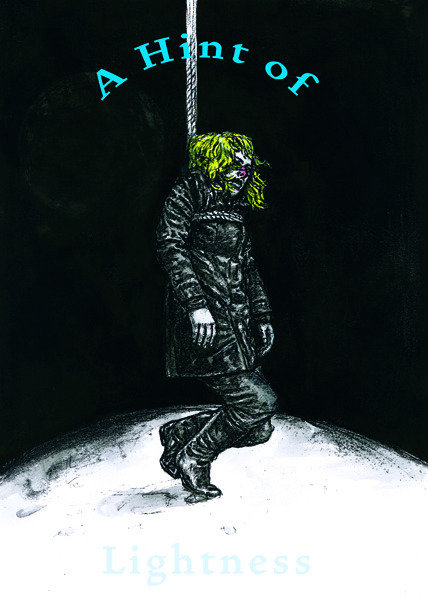Alex Tennigkeit
dal 8/3/2012 al 15/4/2012
Segnalato da
8/3/2012
Alex Tennigkeit
Galerie Jette Rudolph, Berlin
A Hint of Lightness. The focus of the exhibition is on the artist's work with self-portraits - mainly in the form of headshots but also featuring three-quarter and full-body portraits. The play with ambivalence between comedy and despair runs through the entire exhibition.

“Once I thought that to be human was the highest aim a man could have, but I see now that it was meant to destroy me. … I have nothing to do with the creaking machinery of humanity – I belong to the earth! … I can see about me all those cracked forbears of mine dancing around the bed, consoling me, egging me on, lashing me with their serpent tongues, grinning and leering at me with their skulking skulls. I am inhuman!”
(Henry Miller, Tropic of Cancer, 1934)
“A Hint of Lightness” is the title of the new solo exhibition by Alex Tennigkeit, which actually confronts viewers with existential issues of death and violence. The focus of the exhibition is on the artist’s work with self-portraits – mainly in the form of headshots but also featuring three-quarter and full-body portraits.
Exemplary is the large-format canvas “A Desire for Transgression (the Self as Monster)”: the face in the portrait urgently looks at the viewer. It shows the artist bent forward, focused on devouring a messy pile of bloody innards. She is actually in the midst of voraciously gobbling up a heart. The protagonist looks at the viewer in a way that challenges the viewer. Behind her wild curly mess of hair, a dark blue and violet vacuum is brewing and threatens to swallow up everything. In Tennigkeit’s confrontational painting, the act of devouring bloody meat and raw innards is presented in a manner that could be described as the intentional staging of abject objects, which trigger strong, affective reactions such as rejection, contempt or disgust all the way to nausea. The abjection – that, at the same time, is accompanied by feelings of fascination and aims to transgress ethical and moral taboos – depends on the recipient’s particular mood and experiences an increase “… in effect through the power of the imaginary” by, like the obscene, also continually referring to that which is not visible and which is not supposed to be shown. 1
In her 20-part series of portrait paintings subsumed under the collective title “Self as Allegory” Tennigkeit also aims to transgress representational conventions, to explore the limits of representation in painting. So, she freely puts herself in different roles to transform, combine and mask her own physiognomy, and in the process of appropriating motifs, the artist herself assumes the role of author, director, makeup artist and model. This leads to the creation of realistic characters that are nonetheless unusual and impenetrable, and that provoke feelings ranging from pathos to alienation in viewers.
The work “Self as Allegory: Doll of the World” presents a very pronounced portrait of the artist as a doll, using a garish masquerade: big wide-open doll’s eyes, clown-like blush dotting her cheeks and a blond mop of hair crowned with a giant pink ribbon. Her relatively small hands hold the religious symbol of the Christian cross as well as a secular symbol of power. This calculated dramaturgy is put in place to make an impact on viewers: in additional versions, the artist’s face is used as a showplace for grotesque masquerades, desolate mutilations and provocative abjections and present the artist in various images, including as the personification of death in a carnival-like skeleton outfit, in an apparent dialogue with her ancestors and wrestling with her alter ego. Relatively analytical and it gets under your skin – those are the expressions that best describe the portrait, “The Cut,” which presents exactly that: a detailed depiction of a section of the human skull recreated based on Frank H. Netter’s anatomy atlas. A frontal portrait, the white shirt collar below the chin tells viewers it’s a man and also really causes the image to stand out against the homogenous gray-blue background.
The exhibition culminates with a very staged piece, “executio in effigie” (“Execution in Effigy”), where in a life-size painting the artist presents herself hanging upside down in an “execution pavilion” (A.T.). While the structure’s technicalities recall both a decorative garden pavilion and the architecture of a gallows formed of three pillars, they don’t lastly make reference to the historical importance of the exhibition’s location at Strausberger Platz, which in the 16th century was in the vicinity of the square where executions took place in Berlin. Through the form of an artistically staged, “fake self-execution,” the artist occupies an exclusive, circular position, where she makes use of the painting medium to overcome the limits of space and time, which the living body is exposed to. 2
The play with ambivalence between comedy and despair runs through the entire exhibition and is expressed in the choice of an ironic, bitter exhibition title:
“A Hint of Lightness” angrily turns to viewers, undermines and creates distance in the same breath, is an expression of a borderline experience with respect to the question of the art viewer’s expectations and the role of the artist in today’s society.
Opening: Freitag, den 9. März 2012, 18:00 – 22:00 Uhr
Galerie Jette Rudolph GmbH
Strausberger Platz 4, D- 10243 Berlin
open: Tues- Sat 12.00 am- 6 pm



